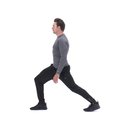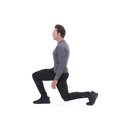Back | Main | Next
The beautiful thing about starting a new program is that everything you do has added meaning when you try it out for the first time, or when you rediscover new tactics. It's the reason why I constantly work with other coaches to prepare my own fitness and diet programs. I know that I'm so close to the situation, I might purposely program around my weaknesses. Submitting to a professional's plan will ultimately keep me on track and lead me to my goals.
The best parts of beginning a fresh approach are also the most difficult. For every new trick you take on with enthusiasm and hope, there's an old trick you must forget and overcome. It's no different than when football players go through a coaching change. Sure it's still football, but there are new plays, new terminology, and depending on your position, there might even be changes to your technique. Despite your best intentions, sometimes you fall back on old behaviors and tendencies, which might be detrimental to your performance.
The Cardio Question
The most difficult fitness aspect to overcome often relates to cardio. For decades, cardio has literally been viewed as the primary way to lose fat. Want to drop a few pounds? Go for a run. Need to burn a few calories after splurging too much for dessert? Hit the treadmill the next day. Need to get in shape for New Years? Just start doing more cardio.
Even now, after five days of being told exactly what to do and not worrying about anything else, I wouldn't be surprised if you did some cardio. Maybe you stepped on the treadmill before or after one of your workouts. Maybe you settled into an elliptical and grinded out an extra 30 minutes, you know, just to help accelerate the process.
There's a method and madness to your diet and weight-training routine, and the same can be said about cardio. You can do cardio and see results, but it's smarter to take a strategic approach that gives you efficient results. This is all about you and making sure you see the changes you want.
Before you start adding mileage, learn how to use cardio to your advantage. Save some time in the gym and use these new coaching tips to upgrade your body.
The Myth Of Running
Traditionally, when most people talk about "doing cardio" they mean they're going for a long run or jog. Intensity (how fast your move) is usually secondary to duration.
I'm not sure who's to blame for this—whether it's bad research, bad information, or just a bad sense of humor—but this approach is not the most efficient way to burn fat. Maybe it's the "calories burned" output on cardio machines that are notoriously inaccurate and make you think longer is better. When you think about it, running for hours on end is not much different than trying to build bigger arms by doing hundreds of reps. More work does not always mean more results, as millions of gym-goers can attest.
There's a science to how your body works. Longer duration slow cardio can burn a lot of calories. It has its time and place—but that time and place is usually not at the start of a new workout. Your body quickly adjusts to this type of cardio, according to research performed at the University of Tampa.
You need to do more and more cardio just to achieve the same results. In a world where we try to make your body more efficient and not waste time in the gym, this is the exact opposite of what you want.
Long, slow cardio has been linked to muscle loss, which is not something you're interested in.
The Best Form Of Cardio For Weight Loss
If you're interested in cardio for fat loss, your best bet is some version of high-intensity interval training (often referred to as HIIT). This type of training comes in many forms and isn't limited to running. You could do alternating sprints, where you run at a fast pace for a short period of time (say 10 to 20 seconds) and then rest for twice as long (20-40 seconds). Repeat this for 8-10 minutes and you're done.
This type of cardio is more effective because—like weight training—the calories you burn aren't limited to when you exercise. When you do low-intensity cardio, you might burn several hundred calories, but the minute you step off the treadmill those calories stop melting. With high-intensity work, you transform your metabolism. When you do high-intensity work, you can increase the number of mitochondria in your muscles. That's just a bunch of fancy scientific words; it means you have greater capacity for fat loss.
Cardio doesn't have to be limited to running. Many people have knee or back pain that can be irritated by the constant pounding on their joints. I always suggest that people strengthen and fix these areas so they are capable of all types of movements, but you can still do HIIT training, with weights. This is called cardio strength training or density training. Combine anywhere from 2-6 exercises in a circuit, and perform them with as little rest as possible. For example, you could combine the following exercises:

BodyFit
$6.99/month- 2,500+ expert-created single workouts
- 3,500+ how-to exercise videos
- Detailed workout instruction
- Step-by-step workout tips
- Training at gym or at home
- Access to Workout Plans
- Access to Bodyfit App
- Store Discounts
Already have a Bodybuilding.com account with BodyFit? Sign In

What comes with BodyFit?

- Instructional Videos
Don't risk doing a workout improperly! Avoid injury and keep your form in check with in-depth instructional videos.

- How-to Images
View our enormous library of workout photos and see exactly how each exercise should be done before you give it a shot.

- Step-by-Step Instructions
Quickly read through our step-by-step directions to ensure you're doing each workout correctly the first time, every time.
The key with high-intensity cardio is that you can burn more fat, while spending a lot less time in the gym. It also allows you to prioritize weight training, and not push yourself to the point that you stop making improvements in the gym, which is the real goal.
So How Long Should I Run?
When doing high-intensity work, it's rare that you'll ever need to do more than 20 minutes when you start your program. You might see that time extended, but that will occur when your intensity is lower. As you begin your program, you'll probably start with just 1-2 days of intervals per week.
Should I Never Perform Long Bouts Of Cardio?
If you're an endurance athlete or preparing for a marathon, 5K, or triathlon, then you'll want to following a training plan which allows you to increase your mileage. If it's something you really enjoy, then there's no reason to avoid the activity. If fat loss and muscle gain is your primary concern, you'll want to limit the duration of your "slower cardio" to 20-30 minutes and just a few times per week. As you know, we already suggested that you take a 20-minute walk on some days. This is great for burning a few extra calories, but also good for your mind and improving your movement.
What If I Hate Running?
Cardio comes in many forms. Whether it's cycling, swimming, using weights, running stairs, or even rowing—the same principles apply. When you do your high-intensity work, push harder for the prescribed period of time, rest appropriately, and repeat. The method is what gives you the results, not the mechanism.
1. Write down your daily goals
2. Sleep 7-8 hours
3. Drink at least 6 glasses of water
4. Include protein in each of your meals
5. Eat veggies at every meal
6. Track your fitness and diet
7. Go for a 20-minute walk
8. Avoid crap foods
9. Foam roll
10. Make a protein shake
11. Find a training partner or join a community
There's no way to sugar coat this. You know it's true. Getting in shape is difficult. Even when you know exactly what to do, are given all the steps to follow, and are completely motivated to make a change, you'll still encounter road blocks. That's why setting up a system to keep you accountable is important. A training partner is an easy way to keep you on track, and help you push yourself harder in the gym. If you can't find someone to join you, virtual training partners in the form of online communities can have a similar effect. They allows you to share your goals and create a network of accountability with others who pursue the same results.




